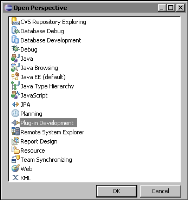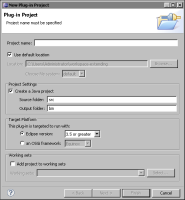Working with the Eclipse PDE
The Eclipse PDE is an integrated design tool used to create, develop, test, debug, and deploy a plug-in. The PDE provides wizards, editors, views, and launchers to assist in developing a plug-in.
The Eclipse PDE provides a wizard, the New Plug-in Project wizard, to assist in setting up a plug-in project and creating the framework for a plug-in extension. The PDE wizard generates the plug-in manifest file, plugin.xml, and optionally, the Java plug-in run-time class.
How to choose the Plug-in Development perspective
To access the PDE, choose the Plug-in Development perspective. To open the Plug-in Development perspective, perform the following tasks:
1 From the Eclipse menu, choose Window➛Open Perspective➛Other. Open Perspective appears.
Figure 17‑2 Selecting a perspective
Choose OK. The Plug-in Development perspective appears.
How to set up a new plug-in project
To access the New Plug-in Project wizard and create a project, perform the following tasks:
1 From the Plug-in Development menu, choose File
➛New
➛Plug-in Project. New Plug-in Project appears, as shown in
Figure 17‑3.
Figure 17‑3 Specifying a plug-in project
Understanding plug-in project properties
The New Plug-in Project wizard defines the following properties for the plug-in:

Project settings

Name

Location

Source and output folders

Target platform, specifying the Eclipse version or OSGi framework

Plug-in content

Properties such as ID, version, name, provider, and the run-time library classpath

Generation of an activator, a Java class that controls the plug-in’s life cycle
Specifying the OSGi framework creates an OSGi bundle manifest, META-INF/MANIFEST.MF, which contains a set of manifest headers that provide descriptive information about the bundle.


